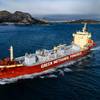Last year, shipowners experienced an average increase of just under four
per cent in their total operating costs, compared to the previous year.
And OpCost 2006, Moore Stephens' operating cost benchmark tool, confirms
that the biggest increases were recorded in respect of insurance and
crew costs.
All vessel categories experienced an increase in total operating costs,
but the increases were not as marked as in the previous year, when
owners were using the cash generated by a period of strong freight rates
to upgrade their ships. This year, overall operating costs in the
tanker market, for example, were up by 5.4 percent on a year-on-year
basis, while a smaller increase - of 3.7 per cent - was recorded in the
bulk carrier sector.
Moore Stephens Shipping Industry Group partner Richard Greiner says,
"Although the percentage increases in total operating expenditure,
overall, were down on the previous year, the significant increases shown
in certain categories emphasise the need for owners and operators to
keep a tight rein on costs.
OpCost 2006 shows that repair and maintenance costs were down by an
overall 1.2 per cent on the previous year. There were, however,
significant variations across different vessel types. Dry cargo
vessels, for example, showed a near-twenty per cent increase in
expenditure on repairs and maintenance. But there was a drop of 18.7 per
cent in the same area for container ships, where big is increasingly
becoming beautiful.
Although the percentage increase in expenditure on crew costs was
actually down on last year, it still came in at an average 9.2 per cent.
These costs were up for almost all vessel types, and VLCCs recorded one
of the highest increases - almost twenty per cent - proving that there
remains a premium for experienced, specialist crew.
Lube oil costs, unsurprisingly given the crises in that market, were
significantly up, but the single biggest increase - of 10.6 per cent -
was recorded in respect of insurance. Dry cargo ships, the workhorses of
the market, recorded the biggest increase, at 31.2 per cent. Cut-throat
competition for business between underwriters in the marine markets has
traditionally served to keep premiums down, but the insurance market may
have gained some courage from a series of big losses. In P&I,
meanwhile, increasing claims costs, higher reinsurance outgoings and
generally uninspiring investment returns saw most of the clubs call for
significant general increases.
The OpCost 2006 report is extracted from Moore Stephens' database of
actual running costs of over 1,300 ships for the year ended 31 December
2005. This year's report covers the twenty most common vessel types.
Operating costs are shown for each vessel type, broken down into five
main groups of crew costs, stores, repairs and maintenance, insurance
and administration. The report also includes an analysis of changes
since last year and information on dry-docking costs and duration.
Running cost information in OpCost is obtained on a confidential basis
from shipping company clients of Moore Stephens, and from shipowners and
managers who voluntarily submit accounts for inclusion. Clients and
voluntary contributors receive free reports, while the report is
available for sale to third parties at US$750 per copy. Special reports
on details within the database can be tailored to individual needs.
Sponsored Content
Anschuetz USA: Supporting the U.S. Maritime Industry

Maritime leaders unite to tackle ocean plastic with launch of new alliance: the Maritime Association for Clean Seas

December 2025
 Read the Magazine
Read the Magazine

 Read the Magazine
Read the Magazine
This issue sponsored by:

Crewed Up, Not Crew Cut: How ARC Is Rethinking Retention at Sea
Subscribe for
Maritime Reporter E-News
Maritime Reporter E-News is the maritime industry's largest circulation and most authoritative ENews Service, delivered to your Email five times per week










